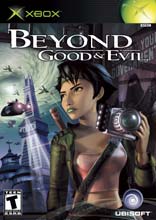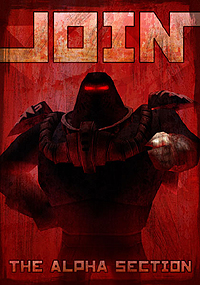 Most games aren't content being just games nowadays; they also want to be movies. Witness the cover story of the New York Times Magazine a few weeks ago, just the latest in a torrent of mainstream news articles comparing the games industry to the movie industry.
Most games aren't content being just games nowadays; they also want to be movies. Witness the cover story of the New York Times Magazine a few weeks ago, just the latest in a torrent of mainstream news articles comparing the games industry to the movie industry.
Yet, even while more game designers aspire to be the Jean Renoir or Orson Welles of their industry, game critics tend to use the descriptor "movie-like" as a backhanded compliment to describe games that focus on dramatic camera angles, story, graphics, and plot to the exclusion of gameplay. Games like Resident Evil and Dragon's Lair come to mind; while both simulate the conventions of movies with astonishing success, both make compromises in the quality of their controls and of the interaction between player and game. Too often, in so-called "movie-like" games, the player passively cranks out a linear story using the controller just as a turn of the century projectionist might turn the crank of a movie projector.
Beyond Good & Evil, the latest effort from Rayman creator Michel Ancel, is a rare exception to this industry trend. It is a game, marvelously engineered and intricately designed, but it also introduces the player to a hermetic, self-generated universe. The player controls Jade, a beautiful freelance reporter and citizen of the planet Hillys. All is not well on Hillys: the planet is under attack from the DomZ, a fearsome race of greenish protoplasmic zenomorphs. Hillys's only defense is the Alpha Section, a shadowy, secretive organization that doesn't seem to have its citizens' best interests at heart. With the help of her pig-humanoid uncle Pey'j and the members of an underground resistance group, Jade must uncover the conspiracy that threatens to destroy her world.
From the exciting introductory sequence in which Jade and Pey'j must protect their home from alien attack, to the moment when Jade gets her first reporting assignment, the game draws the player into its universe instantly and seamlessly. BG&E renders its homeworld in an alluring, yet simple array of bright colors and simple polygonal models. In this regard it recalls Delphine's Out of This World, a game from an earlier era that also managed to create its own unique universe. The player may explore Hillys both on foot and by hovercraft, and even though the adventure unfolds in a linear fashion there is substantial freedom to explore. The player can use the camera to document Hillys' abundant species of animals (and receive special rewards for doing so), examine the breathtaking skyline, and even take personal photographs. Within Hillys there is much to explore. There are cities that look like crosses between Venice and Los Angeles by way of Blade Runner, vast seas broken by the occasional whale and jumping fish, dank sewers, island hideaways, fetid slaughterhouses, and cobblestone market squares. BG&E's world, with its diversity of activity and appearance, engages the player like few game worlds ever conceived.
Another remarkable thing about BG&E is the simplicity of its controls. Not only are the movement commands and camera easy to learn and manipulate, but the platforming aspects are cleverly handled. You'll discover after an hour or so that it is impossible for you to miss a jump, or to fall off an edge; the game automatically guides you when jumping from platform to platform. Of course, the game still allows you to jump wherever you please (an obvious necessity during combat), but the stressful aspects of proper camera placement, gauging distance, timing button presses, and other concerns that plague other games like BG&E are completely absent here.
 This allows you to focus all your attention on snapping photographs and solving puzzles, the true meat of the game. BG&E's puzzles are challenging, yet never to the point of frustration. They also require you to make good use of your partners, Pey'j and Double H. Sometimes you'll need to have Pey'j jump onto something with his rocket boots to propel Jade upward, see-saw style. Or you'll need to have Double H press a button that will open a gate just long enough for Jade to scurry through the opening. Some of the puzzles require you to carefully examine your environment for tiny clues, making use of your camera's zoom function.
This allows you to focus all your attention on snapping photographs and solving puzzles, the true meat of the game. BG&E's puzzles are challenging, yet never to the point of frustration. They also require you to make good use of your partners, Pey'j and Double H. Sometimes you'll need to have Pey'j jump onto something with his rocket boots to propel Jade upward, see-saw style. Or you'll need to have Double H press a button that will open a gate just long enough for Jade to scurry through the opening. Some of the puzzles require you to carefully examine your environment for tiny clues, making use of your camera's zoom function.
The facility of the game's interface allows you to slide effortlessly from one game mode to another. From racing in hovercrafts to stealthily uncovering incriminating evidence, the transition is always organic and unforced. The stealth aspects of the game, while not as complex as something like Splinter Cell, control quite well (sliding across walls and peeking around corners is easily accomplished) and brilliantly raise the tension of the game. It is perhaps this facility in switching from one mode of play to another that makes BG&E so "movie-like." Each task feels not like a discrete, arbitrary "mission" (kill twenty Alpha Section soldiers, steal five pearls, etc.) but like a vital part of the story, with the player cast as the central role.
To reinforce this illusion, BG&E plays entirely in letterbox format. Hillys' beautiful cityscapes and natural vistas look wonderfully vast, and the cut scenes integrate smoothly with the gameplay. It's a nice touch that escapes your notice after playing for a few hours. But it ever-so-subtly reinforces in your mind the grand scope of BG&E's world.
BG&E may not be as long as other adventure games – it caps at around nine or ten hours, perhaps slightly longer if you play to unlock all the hidden stuff – but I didn't really mind. There are no wasted moments in BG&E, no unnecessary dungeons or fetch quests to drag out the game's length. To borrow another overused phrase, in BG&E the focus is on quality not quantity.
A lot of games pretend to be movies, but succeed only in making the player wish he was watching a movie. Not so BG&E: it is a game that, through great ingenuity and care, creates a universe apart from film. Though it may draw influence from the big screen, BG&E never makes the player wish he were anywhere but in its curious and lovely world.
· · · Eric Manch

